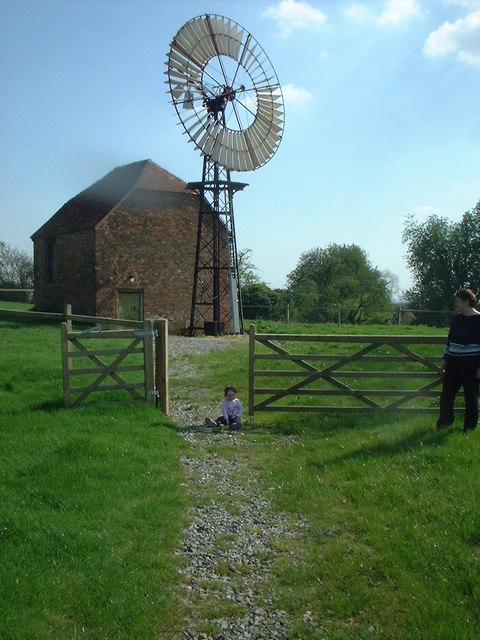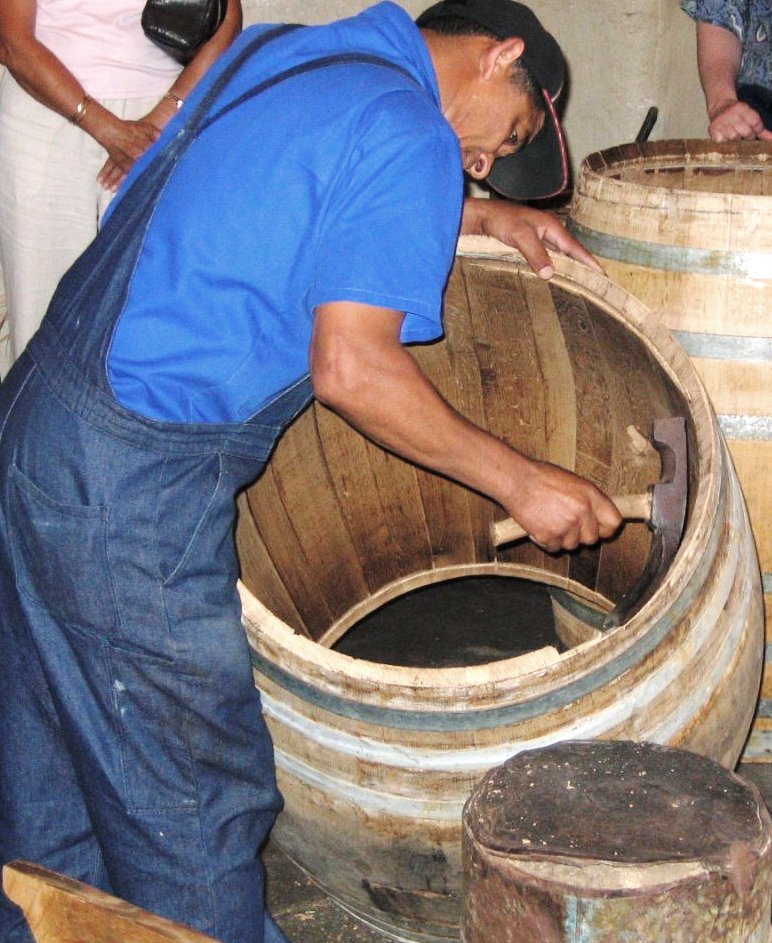|
Buckland Windmill
Buckland Windmill is a grade II listed smock mill at Buckland, Surrey, England which has been restored to working order. It is the only surviving wind saw mill in the United Kingdom. History Buckland Windmill was built by William Cooper, the Henfield millwright, sometime in the 1860s or 1870s. It stands in the grounds of a house that was lived in by the carpenters of the Buckland Court Estate. The windmill was discovered in 1995, with a mature yew tree standing very close to it. When the owners contacted the Society for the Protection of Ancient Buildings for advice, they were surprised to find that it existed, because the mill had been missed by Ken Farries and Martin Mason, and omitted from their comprehensive work on windmills in the county. Restoration The restoration of the mill took place over a number of years, starting in 1995-97 when the building was repaired and made weatherproof. In 1999-2001 the cap frame was constructed and the sails refitted. From 2003, the mill wa ... [...More Info...] [...Related Items...] OR: [Wikipedia] [Google] [Baidu] |
Smock Mill
The smock mill is a type of windmill that consists of a sloping, horizontally weatherboarded, thatched, or shingled tower, usually with six or eight sides. It is topped with a roof or cap that rotates to bring the sails into the wind. This type of windmill got its name from its resemblance to smocks worn by farmers in an earlier period. Construction Smock mills differ from tower mills, which are usually cylindrical rather than hexagonal or octagonal, and built from brick or stone masonry instead of timber. The majority of smock mills are octagonal in plan, with a lesser number hexagonal, such as Killick's Mill, Meopham. A very small number of smock mills were decagonal or dodecagonal in plan, an example of the latter being at Wicken, Cambridgeshire. Distribution Smock mills exist in Europe and particularly in England, where they were common, particularly in the county of Kent, where the tallest surviving smock mill in the United Kingdom, Union Mill, can be found at Cr ... [...More Info...] [...Related Items...] OR: [Wikipedia] [Google] [Baidu] |
Society For The Protection Of Ancient Buildings
The Society for the Protection of Ancient Buildings (SPAB) (also known as Anti-Scrape) is an amenity society founded by William Morris, Philip Webb, and others in 1877 to oppose the Victorian restoration, destructive 'restoration' of ancient buildings occurring in Victorian architecture, Victorian England. "Ancient" is used here in the wider sense rather than the more usual modern sense of "pre-medieval." History Morris' call for the society to be founded was provoked by Sir Gilbert Scott's proposed restoration of Tewkesbury Abbey. In an 1877 letter printed in ''The Athenaeum (British magazine), The Athenæum'', he wrote Alongside Morris, Philip Webb was instrumental in establishing the society in the month following Morris' letter. Initial supporters announced at the group's initial meeting included Thomas Carlyle, John Ruskin, James Bryce, 1st Viscount Bryce, James Bryce, Sir John Lubbock, Leslie Stephen, Coventry Patmore, Edward Burne-Jones, Holman Hunt, Richard Monckt ... [...More Info...] [...Related Items...] OR: [Wikipedia] [Google] [Baidu] |
Smock Mills In England
Smock may refer to one of the following: * Smock-frock, a coat-like outer garment, often worn to protect the clothes * Smocking, an embroidery technique in which the fabric is gathered, then embroidered with decorative stitches to hold the gathers in place * Chemise, a woman's undergarment * A smock mill The smock mill is a type of windmill that consists of a sloping, horizontally weatherboarded, thatched, or shingled tower, usually with six or eight sides. It is topped with a roof or cap that rotates to bring the sails into the wind. This t ..., a windmill with a wooden tower, resembling the garment in appearance * A Ghanaian smock, a shirt worn in Ghana * Smock (surname), list of people with the name {{disambiguation ... [...More Info...] [...Related Items...] OR: [Wikipedia] [Google] [Baidu] |
Windmills In Surrey
A windmill is a machine operated by the force of wind acting on vanes or windmill sail, sails to mill (grinding), mill grain (gristmills), pump water, generate electricity, or drive other machinery. Windmills were used throughout the High Middle Ages, high medieval and early modern periods; the horizontal or panemone windmill first appeared in Persia during the 9th century, and the vertical windmill first appeared in northwestern Europe in the 12th century. Regarded as an icon of Culture of the Netherlands, Dutch culture, there are approximately 1,000 windmills in the Netherlands today. Forerunners Wind-powered machines have been known earlier, the Babylonian emperor Hammurabi had used wind mill power for his irrigation project in Mesopotamia in the 17th century BC. Later, Hero of Alexandria (Heron) in first-century Roman Egypt described what appears to be a wind-driven wheel to power a machine.Dietrich Lohrmann, "Von der östlichen zur westlichen Windmühle", ''Archiv ... [...More Info...] [...Related Items...] OR: [Wikipedia] [Google] [Baidu] |
Industrial Buildings Completed In The 19th Century
Industrial may refer to: Industry * Industrial archaeology, the study of the history of the industry * Industrial engineering, engineering dealing with the optimization of complex industrial processes or systems * Industrial city, a city dominated by one or more industries * Industrial loan company, a financial institution in the United States that lends money, and may be owned by non-financial institutions * Industrial organization, a field that builds on the theory of the firm by examining the structure and boundaries between firms and markets * Industrial Revolution, the development of industry in the 18th and 19th centuries **Second Industrial Revolution * Industrial society, a society that has undergone industrialization * Industrial technology, a broad field that includes designing, building, optimizing, managing and operating industrial equipment, and predesignated as acceptable for industrial uses, like factories * Industrial video, a video that targets “industry” as it ... [...More Info...] [...Related Items...] OR: [Wikipedia] [Google] [Baidu] |
Surrey Historic Buildings Trust
The Surrey Historic Buildings Trust (sometimes abbreviated as SHBT) is a charitable organisation founded in 1980 that works to preserve the architectural heritage of Surrey, in the south east of England. History The Trust was formed in 1980 to help preserve the historic architectural heritage in Surrey for the benefit of future generations by purchasing, selling, and restoring buildings, as well as by making grants and providing advice to owners. It is both a registered charitable trust and a company limited by guarantee. The money employed by the Trust originated in a single founding donation of £25,000 by a former High Sheriff of Surrey, Philip Henman, matched by a grant by Surrey County Council. The trust is managed by a board including members from Surrey County Council, the Surrey Local Government Association, and the Surrey Branch of the Council for the Protection of Rural England. Its advisory 'Working Group' includes architects, planners, conservationists, and arch ... [...More Info...] [...Related Items...] OR: [Wikipedia] [Google] [Baidu] |
Mole Valley
Mole Valley is a local government district in Surrey, England. Its council is based in Dorking, and the district's other town is Leatherhead. The largest villages are Ashtead, Fetcham and Great Bookham, in the northern third of the district. Most of the district is on the escarpments of or adjoins the Surrey Hills, a designated Area of Outstanding Natural Beauty, which cover parts of the North Downs and Greensand Ridge, including locally Leith Hill, Polesden Lacey and Box Hill. Denbies Wine Estate, the largest vineyard in the country, is on the hills north-west of Dorking. The Pilgrims' Way footpath runs along the North Downs. There are stations on the London–Worthing and Reading–Gatwick Airport railways, and in the northern third, a commuter stopping-service pattern line, London–Guildford (via Epsom) line. The A24 road and the M25 motorway are the main thoroughfares and relative to London the incidence of car ownership is high. Between 2011 and its final iteratio ... [...More Info...] [...Related Items...] OR: [Wikipedia] [Google] [Baidu] |
Department For Environment, Food And Rural Affairs
The Department for Environment, Food and Rural Affairs (Defra) is a Departments of the Government of the United Kingdom, ministerial department of the government of the United Kingdom. It is responsible for environmental quality, environmental protection, food production and standards, agriculture, fisheries and rural communities in the entire United Kingdom. Memorandum of understanding, Concordats set out agreed frameworks for cooperation, between it and the Scottish Government, Welsh Government and Northern Ireland Executive, which have devolved responsibilities for these matters in their respective nations. Defra also leads for the United Kingdom on agricultural, fisheries and environmental matters in international negotiations on sustainable development and climate change, although a new Department of Energy and Climate Change was created on 3 October 2008 to take over the last responsibility; later transferred to the Department for Business, Energy and Industrial Strategy ... [...More Info...] [...Related Items...] OR: [Wikipedia] [Google] [Baidu] |
Taxus
''Taxus'' is a genus of coniferous trees or shrubs known as yews in the family Taxaceae. Yews occur around the globe in temperate zones of the northern hemisphere, northernmost in Norway and southernmost in the South Celebes. Some populations exist in tropical highlands. The oldest known fossil species are from the Early Cretaceous. Morphology They are relatively slow-growing and can be very long-lived, and reach heights of , with trunk girth averaging . They have reddish bark, lanceolate, flat, dark-green leaves long and broad, arranged spirally on the stem, but with the leaf bases twisted to align the leaves in two flat rows either side of the stem. The male cones are globose, across, and shed their pollen in early spring. Yews are mostly dioecious, but occasional individuals can be variably monoecious, or change sex with time. The seed cones are highly modified, each cone containing a single seed long partly surrounded by a modified scale which develops into a soft ... [...More Info...] [...Related Items...] OR: [Wikipedia] [Google] [Baidu] |
Windmill Sail
Windmills are powered by their sails. Sails are found in different forms, from primitive common sails to the advanced patent sails. Jib sails The jib sail is found in Mediterranean countries and consists of a simple triangle of cloth wound round a spar. The mill must be stopped in order to adjust the reefing of the sail. Though rare in the UK, at least two windmills are known to have had jib sails (St Mary's, Isle of Scilly and Cann Mills, Melbury Abbas). Image:Windmill Antimahia Kos.jpg, Jib sails Image:Sobreiro.jpg, More fully spread Image:Spanish Mill, St Mary's.jpg, St Mary's, Isles of Scilly File:Cann Mill, Melbury Abbas.jpg, Cann Mills, Melbury Abbas Common sails The common sail is the simplest form of sail. In medieval mills, the sailcloth was wound in and out of a ladder-type arrangement of sails. Medieval sails could be constructed with or without outer sailbars. Post-medieval mill sails have a lattice framework over which the sailcloth is spread. There are v ... [...More Info...] [...Related Items...] OR: [Wikipedia] [Google] [Baidu] |
Carpenter
Carpentry is a skilled trade and a craft in which the primary work performed is the cutting, shaping and installation of building materials during the construction of buildings, ships, timber bridges, concrete formwork, etc. Carpenters traditionally worked with natural wood and did rougher work such as framing, but today many other materials are also used and sometimes the finer trades of cabinetmaking and furniture building are considered carpentry. In the United States, 98.5% of carpenters are male, and it was the fourth most male-dominated occupation in the country in 1999. In 2006 in the United States, there were about 1.5 million carpentry positions. Carpenters are usually the first tradesmen on a job and the last to leave. Carpenters normally framed post-and-beam buildings until the end of the 19th century; now this old-fashioned carpentry is called timber framing. Carpenters learn this trade by being employed through an apprenticeship training—normally four yea ... [...More Info...] [...Related Items...] OR: [Wikipedia] [Google] [Baidu] |





